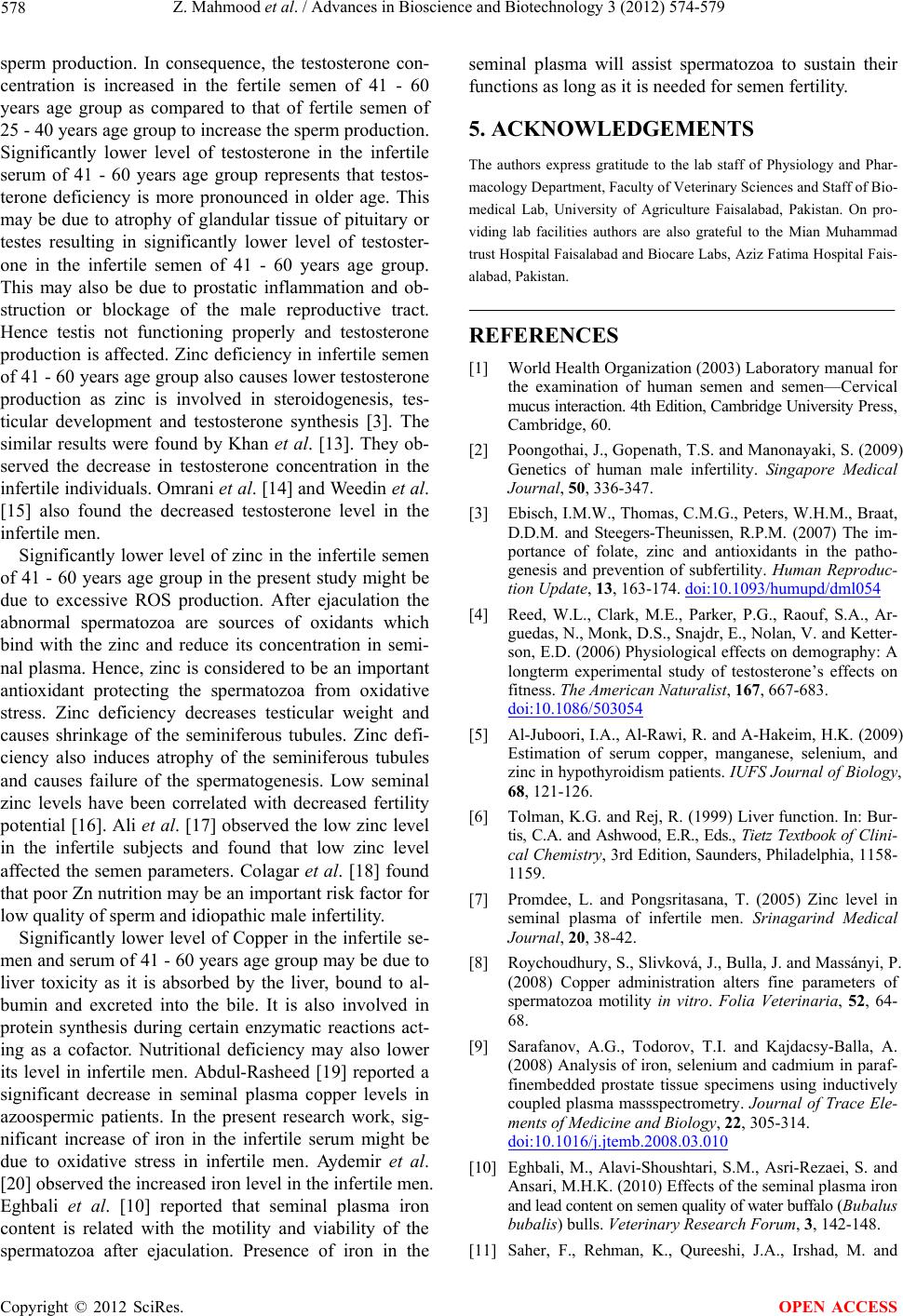
Z. Mahmood et al. / Advances in Bioscience and Biotechnology 3 (2012) 574-579
Copyright © 2012 SciRes.
578
sperm production. In consequence, the testosterone con-
centration is increased in the fertile semen of 41 - 60
years age group as compared to that of fertile semen of
25 - 40 years age group to increase the sperm production.
Significantly lower level of testosterone in the infertile
serum of 41 - 60 years age group represents that testos-
terone deficiency is more pronounced in older age. This
may be due to atrophy of glandular tissue of pituitary or
testes resulting in significantly lower level of testoster-
one in the infertile semen of 41 - 60 years age group.
This may also be due to prostatic inflammation and ob-
struction or blockage of the male reproductive tract.
Hence testis not functioning properly and testosterone
production is affected. Zinc deficiency in infertile semen
of 41 - 60 years age group also causes lower testosterone
production as zinc is involved in steroidogenesis, tes-
ticular development and testosterone synthesis [3]. The
similar results were found by Khan et al. [13]. They ob-
served the decrease in testosterone concentration in the
infertile individuals. Omrani et al. [14] and Weedin et al.
[15] also found the decreased testosterone level in the
infertile men.
OPEN ACCESS
[3] Ebisch, I.M.W., Thomas, C.M.G., Peters, W.H.M., Braat,
D.D.M. and Steegers-Theunissen, R.P.M. (2007) The im-
portance of folate, zinc and antioxidants in the patho-
genesis and prevention of subfertility. Human Reproduc-
tion Update, 13, 163-174.
Significantly lower level of zinc in the infertile semen
of 41 - 60 years age group in the present study might be
due to excessive ROS production. After ejaculation the
abnormal spermatozoa are sources of oxidants which
bind with the zinc and reduce its concentration in semi-
nal plasma. Hence, zinc is considered to be an important
antioxidant protecting the spermatozoa from oxidative
stress. Zinc deficiency decreases testicular weight and
causes shrinkage of the seminiferous tubules. Zinc defi-
ciency also induces atrophy of the seminiferous tubules
and causes failure of the spermatogenesis. Low seminal
zinc levels have been correlated with decreased fertility
potential [16]. Ali et al. [17] observed the low zinc level
in the infertile subjects and found that low zinc level
affected the semen parameters. Colagar et al. [18] found
that poor Zn nutrition may be an important risk factor for
low quality of sperm and idiopathic male infertility.
Significantly lower level of Copper in the infertile se-
men and serum of 41 - 60 years age group may be due to
liver toxicity as it is absorbed by the liver, bound to al-
bumin and excreted into the bile. It is also involved in
protein synthesis during certain enzymatic reactions act-
ing as a cofactor. Nutritional deficiency may also lower
its level in infertile men. Abdul-Rasheed [19] reported a
significant decrease in seminal plasma copper levels in
azoospermic patients. In the present research work, sig-
nificant increase of iron in the infertile serum might be
due to oxidative stress in infertile men. Aydemir et al.
[20] observed the increased iron level in the infertile men.
Eghbali et al. [10] reported that seminal plasma iron
content is related with the motility and viability of the
spermatozoa after ejaculation. Presence of iron in the
seminal plasma will assist spermatozoa to sustain their
functions as long as it is needed for semen fertility.
5. ACKNOWLEDGEMENTS
The authors express gratitude to the lab staff of Physiology and Phar-
macology Department, Faculty of Veterinary Sciences and Staff of Bio-
medical Lab, University of Agriculture Faisalabad, Pakistan. On pro-
viding lab facilities authors are also grateful to the Mian Muhammad
trust Hospital Faisalabad and Biocare Labs, Aziz Fatima Hospital Fais-
alabad, Pakistan.
REFERENCES
[1] World Health Organization (2003) Laboratory manual for
the examination of human semen and semen—Cervical
mucus interaction. 4th Edition, Cambridge University Press,
Cambridge, 60.
[2] Poongothai, J., Gopenath, T.S. and Manonayaki, S. (2009)
Genetics of human male infertility. Singapore Medical
Journal, 50, 336-347.
doi:10.1093/humupd/dml054
[4] Reed, W.L., Clark, M.E., Parker, P.G., Raouf, S.A., Ar-
guedas, N., Monk, D.S., Snajdr, E., Nolan, V. and Ketter-
son, E.D. (2006) Physiological effects on demography: A
longterm experimental study of testosterone’s effects on
fitness. The American Naturalist, 167, 667-683.
doi:10.1086/503054
[5] Al-Juboori, I.A., Al-Rawi, R. and A-Hakeim, H.K. (2009)
Estimation of serum copper, manganese, selenium, and
zinc in hypothyroidism patients. IUFS Journal of Biology,
68, 121-126.
[6] Tolman, K.G. and Rej, R. (1999) Liver function. In: Bur-
tis, C.A. and Ashwood, E.R., Eds., Tietz Textbook of C lini -
cal Chemistry, 3rd Edition, Saunders, Philadelphia, 1158-
1159.
[7] Promdee, L. and Pongsritasana, T. (2005) Zinc level in
seminal plasma of infertile men. Srinagarind Medical
Journal, 20, 38-42.
[8] Roychoudhury, S., Slivková, J., Bulla, J. and Massányi, P.
(2008) Copper administration alters fine parameters of
spermatozoa motility in vitro. Folia Veterinaria, 52, 64-
68.
[9] Sarafanov, A.G., Todorov, T.I. and Kajdacsy-Balla, A.
(2008) Analysis of iron, selenium and cadmium in paraf-
finembedded prostate tissue specimens using inductively
coupled plasma massspectrometry. Journal of Trace Ele-
ments of Medicine and Biology, 22, 305-314.
doi:10.1016/j.jtemb.2008.03.010
[10] Eghbali, M., Alavi-Shoushtari, S.M., Asri-Rezaei, S. and
Ansari, M.H.K. (2010) Effects of the seminal plasma iron
and lead content on semen quality of water buffalo (Bubalus
bubalis) bulls. Veterinary Research Forum, 3, 142-148.
[11] Saher, F., Rehman, K., Qureeshi, J.A., Irshad, M. and